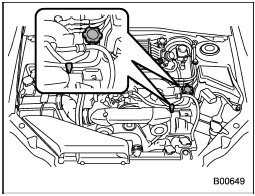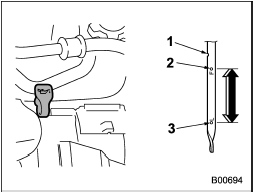Checking the oil level
Check the engine oil level at each fuel stop.
1. Park the vehicle on a level surface and stop the engine.

2. Pull out the level gauge that has the У Ф symbol on top, wipe it clean, and insert it again.
Ф symbol on top, wipe it clean, and insert it again.
3. Be sure the level gauge is correctly inserted until it stops.

1) Notch
2) Upper level
3) Lower level
4. Pull out the level gauge again and check the oil level on it. If it is below the lower level, add oil to bring the level up to the upper level.

Х Use only engine oil with the recommended grade and viscosity.
Х Be careful not to spill engine oil when adding it. If oil touches the exhaust pipe, it may cause a bad smell, smoke, and/or a fire. If engine oil gets on the exhaust pipe, be sure to wipe it off.
Х If the level gauge is not pulled out easily, twist the level gauge right and left, then pull it out. Otherwise, you may be injured accidentally straining yourself.
If you check the oil level just after stopping the engine, wait a few minutes for the oil to drain back into the oil pan before checking the level.
Just after driving or while the engine is warm, the engine oil level reading may be in a range between the upper level and the notch mark. This is caused by thermal expansion of the engine oil.
To prevent overfilling the engine oil, do not add any additional oil above the upper level when the engine is cold.
See also:
Driving with a trailer
● You should allow for considerably more stopping distance when towing a trailer.
Avoid sudden braking because it may result in skidding or jackknifing and loss of
control.
● Avoid ab ...
Auxiliary input jack
By connecting a commercial audio product to the vehicle, such as a portable audio
player, you can hear its sound via the vehicleТs speaker.
An auxiliary (AUX) input jack is equipped in the center ...
Rear window wiper blade rubber
1. Pull out the end of the blade rubber
assembly to unlock it from the plastic
support.
2. Pull the blade rubber assembly out of
the plastic support.
1) Metal spines
3. If the new blade ...


